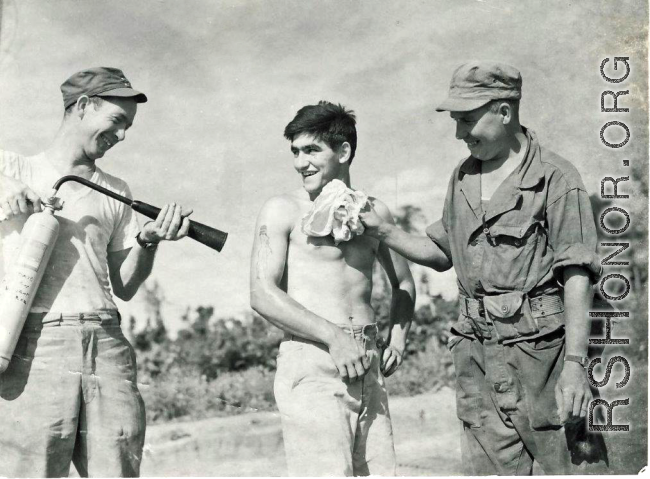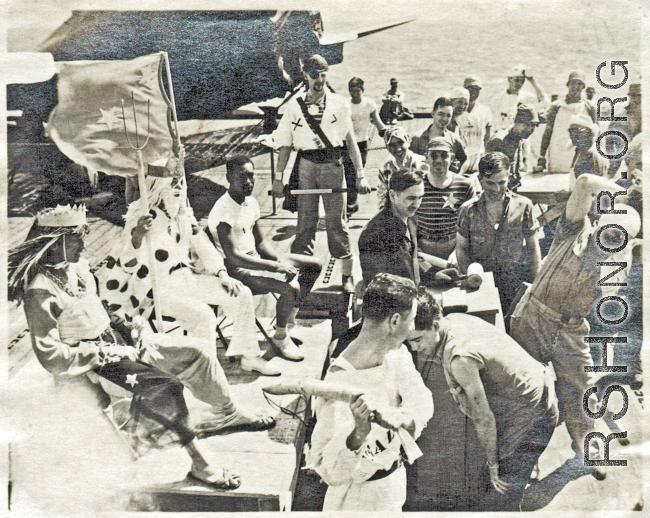Sgt. Andrew R. Allegretto chats with Chinese airmen, with a B-25 in the background. Sgt. Allegretto received the Air Medal for flying on a hazardous mission as part of the "Spray and Pray Squadron," part of CACW. Andrew Ralph Allegretto in CBI arrived aboard MISSION BAY. He volunteered for some of the squadron’s most perilous missions.
ALLEGRETTO, Andrew Ralph ("Swifty", "Andy"), Sgt. (serial #32750955) Born December 18, 1924, in Ocean City, NJ. Son of Michele (Michael) Alfredo and Condita (Iacona) Allegretto, Italian immigrants. Lived in Cape May County, NJ. In 1930, lived with parents and four siblings, address 933 Simpson Ave., Ocean City, NJ, student. Not found in 1940 census. Registered for the draft on December 29, 1942, same address as census, employer W. Bartholomew, 9th & Asbury Ave., Ocean City, next of kin Mike Allegretto (brown eyes, brown hair, ruddy complexion, 5' 3", 140#). Enlisted on February 13, 1943, in Camden, NJ, as a private (completed two years of high school, occupation gas station attendant, 5' 5", 138#). Arrived at Karachi aboard USS Mission Bay on March 29, 1944. Assigned to 3rd squadron as A/P armorer. Promoted to corporal on June 1, 1944. Assigned to detached service with Task Force 34 at Chihkiang. Treated with penicillin for undisclosed disease in October and December 1944. Promoted to sergeant on April 1, 1945. Awarded Air Medal on April 9, 1945; also received the American Service Medal, Asiatic-Pacific Service Medal, Good Conduct Medal, and World War II Victory Medal. Assigned to 4th Bomb Squadron Detachment at Chihkiang in August 1945. Diagnosed and treated for cellulitis of buttock and hip during same month. Transferred to 23rd Fighter Group, 68th Composite Wing, for transport home. Wood's address list at end of the war: 933 Simpson Ave., Ocean City, New Jersey. Released from service December 24, 1945. Married Madeleine ("Maddy") Sannino in 1946; parents of ten sons and two daughters. Had a tattoo of a nude woman on his arm; later added shorts and a top at insistence of wife and mother. Worked for various plumbing companies before establishing Allegretto Plumbing and Heating in Ocean City, NJ; still in operation by his family. Died February 10, 2006; cause cancer. Buried at Cape May County Veterans Cemetery, Cape May Court House, NJ.

After the squadron evacuated from Kweilin in mid-September 1944, it moved to Peishiyi. Bad weather and a severe gas shortage restricted missions out of that base, so detachments from the 3rd and 4th Bomb Squadrons moved to Chihkiang to form Task Force 34. Their primary targets were enemy truck convoys moving through the Hsiang Valley, but they also made several raids against Hankow-Wuchang (Wuhan). This account describes the first of those, in November 1944:
Carrying twelve M41 stabilized frag clusters fused instantaneous, Capt. Lyon took off from Chihkiang in the 3rd squadron's A/C #722 at 1805 on the 22nd. With him were Maj. A. T. House, 68th Composite Wing, as observer and copilot and a crew that included Sgt. Peters and Cpl. Allegretto as waist and tail gunners and the 4th squadron's Capt. Wei as navigator and S/Sgt. Weinert as top turret gunner. They had volunteered for this hazardous mission without knowing what it actually entailed until the briefing just before takeoff. It was a combined mission with the 68th Composite Wing that included twenty-two B-24s of the 308th Bomb Group (H) and two P-51s of the 75th Fighter Squadron, 23rd Fighter Group. Their destination was Hankow-Wuchang (jointly called Wuhan), an important transportation hub formerly used as headquarters of the Kuomintang government but now occupied by the Japanese. Its factories, warehouses, and stockpiles would be the target of countless 14th Air Force raids throughout the war. Portaluppi noted, "To us who had previously considered Hankow safe only at 8000 feet or above, the mission had every earmark of a semi-suicidal venture."
He provided details of the attack in the 4th squadron's historical report:
The mission, flown at the request of the 14th Air Force and the 68th Composite Wing, was to test the feasibility and effectiveness of a B-25 to support heavy bomber night operations against searchlights and interdicting their use during bomb runs. The target area was Hankow-Wuchang, which is heavily defended by anti-aircraft, searchlights, and night fighters; their specific objective was the searchlights on the Wuchang side. Two P-51's were assigned to the Hankow side. The Jap searchlight tactics varied between master-control apparently mechanically pointed, and control by a single directing light. There was no scissoring and little independent searching. Their reaction to attack was to put out all their lights at once. After the first pass the searchlights were turned out then immediately turned on again. The pilot promptly attacked them again[,] and again they were turned out. The Mitchell then circled out of range taking constant evasive action. The heavies approached the target and made their runs singly or in small groups, and each time the searchlights were turned on in an attempt to pick them up the lights were attacked. The pilot devised tactics which made full use of the fire power of the Mitchell within the limitations of its maneuverability and yet kept risks to the aircraft at the minimum. But at the same time the attack was pressed with aggressive determination. In addition to uncounted passes and maneuvers to bring the turret and waist guns to bear, fourteen forward firing passes were made on searchlight positions. During three bomb runs the searchlights were turned, out when the Mitchell turned into the lights; and on one bomb run the lights were not turned on at all. It was impossible to prevent completely interference by the searchlights as some bomb runs were made when the Mitchell was turning away from the target. The conclusions drawn from the experiences of the mission was that the use of a Mitchell to support heavy bomber night operations by attacking searchlights was both feasible and effective.
According to Task Force 34's operational intelligence report for mission #21, the aircraft remained in the target area for an hour and thirty minutes after the last heavy bomber appeared. No fires or secondary explosions were seen in the target area. The Mitchell's frag load was dropped on revetments at Wuchang Airdrome. Meager light automatic weapons fire was silenced by fire from the aircraft. On the return flight two remaining bomb clusters were dropped on Pailochi Airdrome. Only slight opposition was encountered and a radar position three miles southwest of the airdrome was shot up. Gunners expended a total of 1,100 rounds of .50-caliber ammunition on strafing attacks.

Return through the Yangtze Valley was at minimum altitude and with constant change of course and altitude because the tracers of a night fighter were seen as the aircraft was leaving the Hankow-Wuchang area. Lyon flew the Mitchell on to Yiyang, where it was to have rendezvoused with the P-51s, and circled with lights on. No answer was given to radio calls and it became evident that the fighters had taken advantage of the good visibility to go directly home. A/C #722 then continued on to Chihkiang, where it was down safely at 2315.
The 4th squadron's Sgt. Oswald Weinert, turret gunner on this Wuhan raid, later wrote this first-hand account: "At Hankow-Wu Chang area, the Japanese held a strongly fortified depot area, in 2 areas about 5 miles apart, for ammunition and fuel. The towns were on the mouth of the river leading to the Tungting [Dongting] Lake, an important supply depot area where other transportation would distribute supplies. Several other units (P-40, P-38, A-20's) had unsuccessfully attempted to destroy the search lights in the area and some even died. We were aware how difficult it would be. The mission was to go in advance and shoot out their big searchlights so the B-29 and B-24 heavy-duty bombers could finish the strike. Major Lyon was one of the best pilots there was to lead the mission. There were 5 crew on the B-25 - 1 pilot, 1 navigator, and 3 gunners. I was the only gunner from the 4th while the others were from other squadrons to volunteer. I wasthe crew chief as well as gunner." It was Weinert's opinion that Lyon had "certainly earned the Silver Star that night". Although he had been recommended for the Distinguished Flying Cross for this mission, Weinert did not follow through with the paperwork necessary to receive it until many years afterward.
Although Cpl. Allegretto, armorer-gunner on this mission, did not learn the exact target until soon before takeoff, he later stated that he "had prior knowledge of the heavily-defended target area and knew that the weather to and from the target was poor, that icing conditions were prevalent and that enemy night fighters probably would be in evidence".
Afterward he confided to Hank and other buddies that he would not have volunteered if he had known how dangerous the mission would be. Allegretto did his duty and would later be promoted and awarded the Air Medal for this mission. The citation that accompanied it read, in part, "Throughout the entire mission Sergeant Allegretto displayed superior technical skill as well as aggressive courage. His expert airmanship and his profound devotion to duty at a time of extreme personal danger denote outstanding achievement in aerial flight and exemplify the finest traditions of the U.S. Army Air Forces."
Allegretto and Peters were the only 3rd squadron members of this mission. Others mentioned are from the 4th squadron.
(Thanks for supplemental images and text/information from M. Kincannon.)
